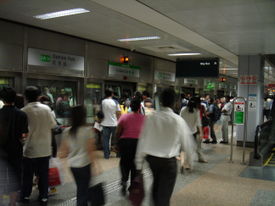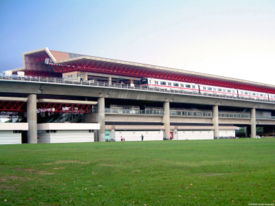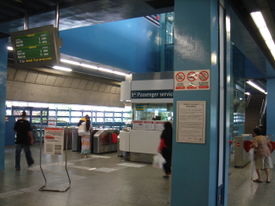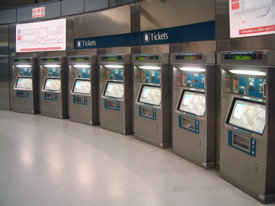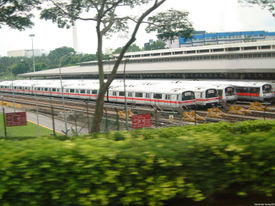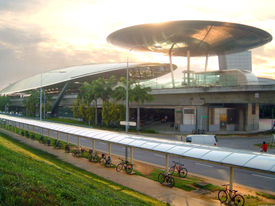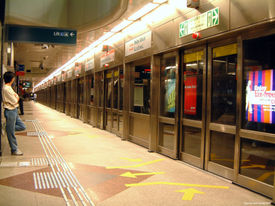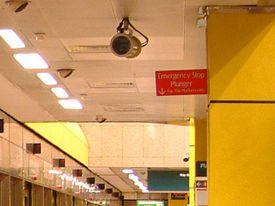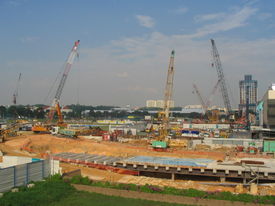Mass Rapid Transit (Singapore)
2007 Schools Wikipedia Selection. Related subjects: Railway transport
 |
|
| Locale | Singapore |
|---|---|
| Transit type | Rapid transit |
| Began operation | 7 November 1987 |
| System length | 109.4 km |
| No. of lines | 3 |
| No. of stations | 64 |
| Daily ridership | about 1.338 million (2005) |
| Track gauge | 1435 mm ( standard gauge) |
| Operator | SMRT Corporation, SBS Transit |
The Mass Rapid Transit or MRT (Chinese: 大众快速交通 or more commonly known as 地铁; Malay: Sistem Pengangkutan Gerak Cepat; Tamil: சிங்கை துரிதக் கடவு ரயில்) is a rapid transit system that forms the backbone of the railway system in Singapore with a network spanning the entire city-state. The initial section of the MRT, between Yio Chu Kang and Toa Payoh, was opened in 1987, establishing the MRT as the second oldest metro system in Southeast Asia after Manila's LRT System.
The network has since grown rapidly as a result of Singapore's aim of developing a comprehensive rail network as the main backbone of the public transport system in Singapore. In 2005, the average daily ridership on the MRT network was about 1.338 million. While this figure pales in comparison to the bus network's 2.785 million, it was nonetheless an 76% increase compared to figures in 1995 (0.760 million), while the bus network saw a 8.1% drop in ridership in the same period. This trend is expected to continue as current public transport policies promote the expansion of the rail network at the expense of bus services which are withdrawn or reduced to avoid duplication of services.
The MRT has 64 operating stations with 109.4 kilometres of lines, and operates on standard gauge. The rail lines have been constructed by the Land Transport Authority, a department of the government of Singapore, which allocates operating concessions to the profit-based corporations SMRT Corporation and SBS Transit. These operators also run bus and taxi services, thus ensuring that there is a full integration of public transport services. The MRT is complemented by the regional Light Rapid Transit (LRT) systems which links the MRT stations with the respective HDB public housing estates they serve. Services operate from about 5:30 am and usually end before 1 a.m. daily with frequencies of approximately five minutes, and services being extended during festive periods.
The current Mass Rapid Transit network
|
History of the MRT
The origins of the Mass Rapid Transit are derived from a forecast by city planners in 1967 which stated the need for a rail-based urban transport system by 1992. Following a debate on whether a bus-only system would be more cost-effective, the Parliament came to the conclusion that an all-bus system would be inadequate, since it would have to compete for road space in a land-scarce country. The initial S$5 billion construction of the Mass Rapid Transit network was Singapore's largest public works project at the time, starting on 22 October 1983 at Shan Road. The network was built in stages, with the North South Line given priority because it passed through the Central Area that has a high demand for public transport. The Mass Rapid Transit Corporation—MRTC, later called the SMRT Corporation—was established on 14 October 1983; it took over the roles and responsibilities of the former provisional Mass Rapid Transit Authority. On 7 November 1987, the first section of the North South Line started operations, consisting of five stations over six kilometres. Fifteen more stations were later opened, and the MRT system was officially launched on 12 March 1988 by Lee Kuan Yew, then Prime Minister of Singapore. Another 21 stations were subsequently added to the system; the opening of Boon Lay station on the East West Line on 6 July 1990 marked the completion of the system two years ahead of schedule.
The Mass Rapid Transit has subsequently been expanded. This includes a S$1.2 billion expansion of the North South Line into Woodlands, completing a continuous loop. The concept of having rail lines that bring people almost directly to their homes led to the introduction of the Light Rapid Transit (LRT) system into the existing Mass Rapid Transit network. On 6 November 1999, the first LRT trains on the Bukit Panjang LRT Line went into operation. To promote tourism, the Changi Airport and Expo stations were built. The North East Line, the first line operated by SBS Transit, opened on 20 June 2003 and became one of the first fully automated heavy rail lines in the world.
Station facilities, amenities and services
All MRT stations are either above-ground or underground except for Bishan station, which is at ground level. Most underground stations are deep enough to withstand conventional aerial bomb attacks and to serve as bomb shelters.
Every station has at least four General Ticketing Machines (GTMs), a Passenger Service Centre, LED and plasma displays that show train service information and announcements. All stations are equipped with restrooms and payphones, although some restrooms are located on street level. Some stations, especially the major ones, have additional amenities and services, such as retail shops and kiosks, supermarkets, convenience stores such as 7-Eleven or Cheers, automatic teller machines, and self-service automated kiosks for a variety of services.
The older stations on the North South Line and East West Line were not originally constructed with fully accessible facilities, such as lifts, ramps, tactile guidance systems and toilets for passengers with disabilities. However, these facilities are being progressively installed as part of a program to make all stations accessible to the elderly and the those with disabilities. As of 16 September 2006, all stations with the exception of Buona Vista Station & Bishan Station are barrier free.
Fares and tickets
Because the rail operators are government-assisted, profit-based corporations, fares on the MRT system are pitched to at least break-even level. The operators collect these fares by selling electronic data-storing tickets, the prices of which are calculated based on the distance between the start and destination stations. These prices increase in fixed stages for standard non-discounted travel. Fares are calculated in increments based on approximate distances between stations, in contrast to the use of fare zones in other subway systems, such as the London Underground. As the fare system has been integrated by TransitLink, commuters need pay only one fare and pass through two fare gates during the entire journey, even when transferring between lines operated by different companies. Commuters can choose to extend a trip mid-journey, and pay the difference as they exit their destination station.
Stations are divided into two areas, paid and unpaid, which allow the rail operators to collect fares by restricting entry only through the fare gates, also known as access control gates. These gates, connected to a computer network, are capable of reading and updating electronic tickets capable of storing data, and can store information such as the initial and destination stations and the duration for each trip. General Ticketing Machines sell tickets for single trips or allow the customer to purchase additional value for stored-value tickets. Tickets for single trips, coloured in green, are valid only on the day of purchase, and have a time allowance of 30 minutes beyond the estimated travelling time. Tickets that can be used repeatedly until their expiry date require a minimum amount of stored credit.
Although operated by private companies, the system's fare structure is regulated by the Public Transport Council, to which the operators submit requests for changes in fares. Fares are kept affordable by pegging them approximately to distance-related bus fares, thus encouraging commuters to use the network and reduce its heavy reliance on the bus system. Fare increases over the past few years have caused public concern. There were similar expressions of disapproval over the slightly higher fares charged on SBS Transit's North East line, a disparity that SBS Transit justified by citing higher costs of operation and maintenance on a completely underground line, as well as lower patronage.
Magnetic tickets (1987–2002)
When the MRT first came into operation in 1987, fares ranged from S$0.50 to S$1.10 in S$0.10 increments for all adult tickets, regardless of whether they were single-trip or stored-value tickets. Several discounted fares were available: senior citizens and permanent residents above the age of 60 could travel on a flat fare of S$0.50 during off-peak hours; children below the height of 1.2 metres and full-time students in primary, secondary, pre-university and vocational training (VITB) institutions paid a flat fare of S$0.30 at all times.
Magnetic strip plastic tickets were used, in various forms. Stored-value tickets were called farecards and came in three types: the blue farecard was issued to adults, the magenta farecard to senior citizens, and the red farecard to children. Single-trip forms of these tickets were retained at the faregates on exiting the paid area of a destination station. Monthly discounted tickets were available in four values: beige, pink, and purple tickets for primary and tertiary students, and full-time national servicemen came with a value of S$13, S$30 and S$36, respectively; the peach ticket was for secondary, pre-university and VITB students, costing S$17 each. These discounted tickets were valid for a month from the date of purchase, allowed up to four trips a day, and were non-transferable.
EZ-Link cards and Standard Tickets (2002–present)
The EZ-Link card is a contactless smartcard based on Sony's FeliCa smartcard technology. These cards are used for making payments for some goods and services in Singapore, mainly transportation services. Established in 2002, the technology was promoted as a means for speedy and convenient transactions, and an efficient method of reducing fare evasion, although there have been some cases of overcharging users. As a benchmark, fares range from S$0.69 to S$3.04 for adults, S$0.64 to S$0.70 for senior citizens, and S$0.40 to S$0.50 for student EZ-Link cards.
The General Ticketing Machines (GTMs) at each station, replacing older ticket machines, allow commuters to purchase additional credit to add to their EZ-Link cards or to purchase tickets for single trips. Fares for these single-trip forms of these cards range are between one or two times the expense of non single-trip tickets. In addition, a S$1.00 refundable ticket deposit is charged for each Standard Ticket. This refund can be collected from any General Ticketing Machine when the card is returned to the machine within 30 days of purchase. The card can also be left in a charity collection box, thereby donating the S$1.00 deposit. The smartcard technology contained in each Standard Ticket makes each one costly enough to necessitate recycling of Standard Tickets. Concession fares are available for children, students, senior citizens and national servicemen. The Visitor's Card, which offers a package of services to tourists, can be used as an EZ-Link card.
Students are given free, personalised cards, complete with their photos, names and national identification numbers. Regardless of its type, each card is assigned a unique card ID that can be used to recover the card if lost. Transport operators have organised lotteries that are based on these card IDs.
MRT rolling stock
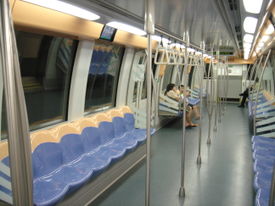
Three types of rolling stock are used to carry passengers on both the North–South Line and the East–West Line. They are powered by 750-volt DC third rail, operate in sets of six cars, and use the automatic train operation system (ATO) that is similar to London Underground's Victoria Line.
The majority of the fleet comprises 396 C151 Cars; these are the oldest trains that are still in operation, as of 2006. They were built between 1986 and 1989 by Kawasaki Heavy Industries in consortium with Nippon Sharyo, Tokyu Car Corporation and Kinki Sharyo. A S$142.7 million upgrade of these trains is under way and will be completed by 2008.
In 1994, 114 C651 Cars, manufactured by Siemens of Germany, were purchased to complement the existing fleet of C151 trains when the Woodlands extension opened. Some of these trains have been previously reconfigured in experimental programs to accommodate more passengers, but such arrangements have since been abandoned.
Between 1998 and 2001, 126 C751B Cars built by Kawasaki Heavy Industries and Nippon Sharyo in a joint venture were introduced. Kawasaki Heavy Industries manufactured 66 cars and Nippon Sharyo manufactured 60 cars respectively. The cars have a sleeker design and come with an improved passenger information system, more grab poles, wider seats, more space near the doors and spaces for wheelchairs. As these trains were originally intended to operate on a direct service from Boon Lay to Changi Airport, luggage racks were installed for air travellers. However, in April 2002 faulty gearboxes forced all 21 train-sets to be off-service, and the service was temporarily suspended. The direct service was scrapped in July 2003, and the luggage racks were removed.
Since its opening in 2003, 150 driverless Alstom Metropolis Cars have been operating on the North East Line. Alstom Transportation of France was contracted by Land Transport Authority in 1997 and 1998 to supply these cars. They are fully automatic, powered by overhead lines on 1,500 volts DC, and are the first trains to have closed-circuit cameras (CCTV) installed within their interiors. A further order of 120 cars is due to be delivered when the Circle Line starts operations in 2007.
Depots
SMRT Corporation has 4 train depots: The Bishan depot is the central maintenance depot with train overhaul facilities, while the Changi and Ulu Pandan depots only inspect and house trains overnight. The underground Kim Chuan Depot houses trains for the Circle Line. Ang Mo Kio, Jurong East and Tanah Merah stations were built with a third middle track for off-service trains to stop at before they return to their depots, but the last two are now used as termini for the North South Line and the Changi shuttle, respectively.
The Sengkang Depot houses trains for the North East Line, the Sengkang LRT and the Punggol LRT, all operated by SBS Transit. It is the first depot to have structual provisions for an industrial development located above the depot, to minimize the wastage of land in land-scarce Singapore.
Architecture and art on the MRT
Early stages of the MRT's construction paid relatively scant attention to station design, with an emphasis on functionality over aesthetics. This is particularly evident in the first few stages of the North–South Line and the East–West Line that opened between 1987 and 1988 from Yio Chu Kang to Clementi. Architectural themes became an issue only in subsequent stages, and resulted in such designs as the cylindrical station shapes on most stations between Kallang and Pasir Ris, and the perched roofs on stations to the west of Jurong East.
Art pieces, where present, are seldom highlighted; they primarily consist of a few paintings or sculptures representing the recent past of Singapore, mounted in major stations. The opening of the Woodlands Extension introduced bolder pieces of artwork, such as the large hanging sculpture in the Woodlands MRT Station. With the opening of the North East Line, a series of artworks created under a programme called "The Art In Transit" were commissioned by the Land Transport Authority. Created by 19 local artists and integrated into the stations' interior architecture, these artworks aim to promote the appreciation of public art in high-traffic environments. The artwork for each station is designed to suit the station's identity. Only stations on the North East Line come under this programme.
Along the extension to the East-West line connecting to Changi Airport, the Expo Station is sited adjacent to the 100,000 square metre Singapore Expo exhibition facility. Designed by Foster and Partners and completed in January 2001, the station features a large pillarless titanium clad roof in an elliptical shape that sheathes the length of the station platform. This complements a smaller 40 metre reflective stainless steel disc overlapping the titanium ellipse and visually floats over a glass elevator shaft and the main entrance.
Safety on the MRT
Assurance has been given by both operators and authorities, that numerous measures have been taken in an effort to ensure the safety of passengers, with SBS Transit having to make greater efforts in actively publicising its safety considerations on the driver-less North East Line before and after its opening. Safety campaign posters are highly visible in trains and stations, and the operators frequently broadcast safety announcements to passengers and to commuters waiting for trains. Fire safety standards are consistent with the strict guidelines of the US National Fire Protection Association. Platform screen doors are installed at all underground stations. These doors prevent suicides, enable climate control in stations and prevent unauthorised access to restricted areas. Above-ground stations have open platforms, with a wide yellow line drawn along each platform edge requiring passengers to stand at a safe distance from arriving trains (or face a fine). Bylaws are implemented in the system to deter uncivil, disruptive and dangerous acts, such as smoking, the consumption of food and drinks, the frivolous use of safety features, and trespassing onto the railway tracks. Penalties ranging from fines to imprisonment are imposed for these offences.
Safety concerns were raised among the public after several accidents on the system during the 1980s and 1990s, but most problems have been rectified. On 5 August 1993, two trains collided at Clementi station because of an oil spillage on the track, which resulted in 132 injuries. There were calls for platform screen doors to be installed at above-ground stations after several incidents in which passengers were killed by oncoming trains when they fell onto the railway tracks at above-ground stations. However, the authorities rejected the proposal, because of doubts over functionality and concerns about the high installation costs.
Security on the MRT
Security concerns related to crime and terrorism were not high on the agenda of the system's planners at its original inception. However, in the wake of heightened security concerns after the foiled plot to bomb the Yishun MRT Station and the Madrid train bombings in 2004, the operators deployed private, unarmed guards to patrol station platforms and check the belongings of commuters.
Recorded announcements are frequently made to remind passengers to report suspicious activity and not to leave their belongings unattended. Digital closed-circuit cameras (CCTVs) are being upgraded with recording-capability at all stations and trains operated by SMRT Corporation. Trash bins and mail boxes have been removed from station platforms and concourse levels to eliminate the risk that bombs will be placed in them.
On 14 April 2005, the Singapore Police Force announced plans to step up rail security by establishing a specialised Police MRT Unit. These armed officers began overt patrols on the MRT and LRT systems on 15 August 2005, conducting random patrols in pairs in and around rail stations and within trains. They are trained and authorised to use their firearms at their discretion, including deadly force if deemed necessary. On 8 January 2006, a major civil exercise involving over 2,000 personnel from 22 government agencies, codenamed Exercise Northstar V, simulating bombing and chemical attacks at Dhoby Ghaut, Toa Payoh, Raffles Place and Marina Bay MRT stations was conducted. Thirteen stations were closed and about 3,400 commuters were affected during the three-hour duration of the exercise.
Future expansion
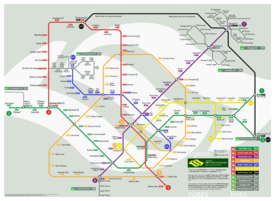
The MRT system had relied on its two main lines, namely the North–South and East–West Lines, for more than a decade until the opening of the North East Line in 2003. While plans for these lines, as well as those currently under construction, were formulated long before, the Land Transport Authority's (LTA) publication of a white paper entitled "A World-Class Land Transport System" in 1995 galvanised the government's intentions to greatly expand on the existing system. The plans allow for the long-term replacement of the bus network by rail-based transportation as the primary mode of public transportation. It called for the expansion of the existing 67 kilometres of track (in 1995) to over 160 in 10 to 15 years, and envisaged further expansion in the longer term. By 2030, the government envisages a rail network of 540 kilometres — more extensive than London's 408-kilometre Tube system.
Circle Line
Currently under construction in five stages, the 33.3-kilometre Circle Line will be the next major rail line to open after the North East Line began operating in June 2003. It was originally scheduled to be opened in stages from 2007 to 2010, but the completion of the first stage was postponed to about 2010 when a section of tunnel near the Nicoll Highway station collapsed on 20 April 2004 during its construction and caused the death of four workers. The other four stages are expected to be opened progressively and on schedule from 2008 to 2010. When completed, the line will connect all the existing MRT lines, and will allow commuters to travel around the country without needing to go downtown to interchange with another line, reducing congestion especially at City Hall and Raffles Place stations.
It is also expected to have a Stage 6 which completes the circle from HarbourFront to Promenade stations.
East West Line Boon Lay Extension
The plan for Boon Lay MRT Extension (BLE) was announced by the Land Transport Authority on 29 December 2004. The 3.81-kilometre, two-station extension will extend from Boon Lay MRT Station on the western end of the East West MRT Line, with one station along Jurong West Street 63 (station name: Pioneer), between Jurong West Street 61 and Pioneer Road North, and the second station at Joo Koon Circle (station name: Joo Koon), near the junction of Benoi Road and International Road.
The fully elevated extension will cost about S$436 million, which is expected to be completed by 2009. Construction works commenced on 11 March 2006. The alignment of the extension along Jurong West Street 63, Upper Jurong Road, and International Road has required the acquisition of 28,000 square metres of land.
Downtown Line Phase 1
On 14 June 2005, the Land Transport Authority announced that it would construct a Downtown Extension (DTE) to serve the Downtown at Marina Bay (DTMB) area, where an integrated resort and Singapore's second botanical garden will be located. The 3.4-kilometre fully underground extension is estimated to cost S$1.4 billion. Construction of the extension is to start by 2007, with completion by 2012.
Three new stations will be constructed underground, linking the Promenade station on the Circle Line and the Chinatown station on the North East Line. Two stations, tentatively named Bayfront and Landmark, will be built to serve the DTMB area. Another station, tentatively named Cross Street, will be built along Cross Street near the Chinatown area.
Future lines
The LTA is currently conducting feasibility studies for the 40 kilometre Downtown Line which will connect the northwestern and eastern regions of Singapore to the new downtown at Marina Bay, Singapore in the south. The Downtown Line will be a merger of the previously planned Bukit Timah Line, the Eastern Region Line and the confirmed Downtown Extension, now referred to as the Downtown Line Phase 1. .
Previously, the Bukit Timah Line was to be a 20-kilometre line that would connect the new downtown with the Bukit Panjang, Upper Bukit Timah and Bukit Timah corridor. It was to intersect the Circle Line and some other lines along the way. When constructed, it was expected to alleviate the heavy traffic along Bukit Timah, Dunearn Road and Upper Bukit Timah. Provisions have been made at Promenade Station which would have been the line's southern interchange with the Circle Line. Preliminary work has recently begun — LTA was looking at possible station locations, soil profile and engineering challenges. If works had begun by 2010, when the Circle Line is completed, Bukit Timah Line would have been completed by 2016.
The Eastern Region Line was also to be a 40-kilometre rectangular loop that would complement the existing East-West Line and enhance inter- and intra-town travelling in the eastern region. It would have looped around the Jalan Besar and East Coast areas, intersecting the Circle Line and other lines along the way, benefitting residents in Tampines, Bedok, Marine Parade, MacPherson and Kaki Bukit. Provisions have been made at Chinatown Station, which would have been the line's western interchange with the North-East Line and the Downtown Line Phase 1. The northern segment of the loop was to be constructed first, passing through Jalan Besar area and eastwards to parts of Bedok and Tampines. Like the Bukit Timah Line, preliminary work had recently begun — LTA was currently looking at possible station locations, soil profile and engineering challenges. If works had begun in 2016, the first segment of Eastern Region Line would have been ready by 2020.

